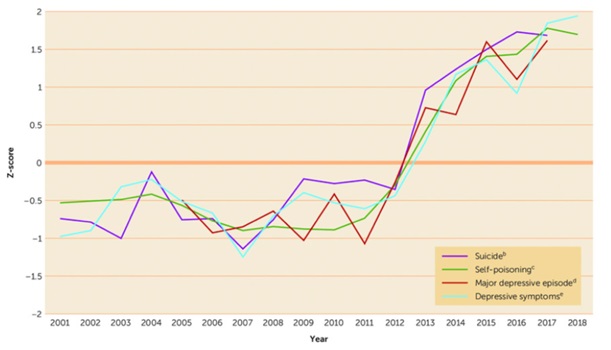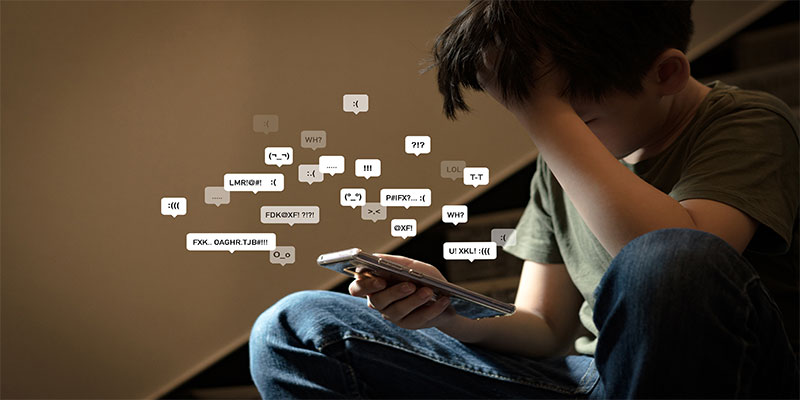An important message to all parents… This disturbing study shows the kids are not alright… These are the new cigarettes… Plus, five rules I encourage you to follow at home…
- Here’s what scares me.
It’s not a stock market crash, or some rogue artificial intelligence taking over the world and killing us all.
It’s our phones.
Yes, you read that right. I’m really worried about that supercomputer you carry around in your pocket all day.
Specifically, the harm they’re causing our kids...
If you’re a parent, this is one of the most important essays you’ll read all year. And please don’t ignore the five actions to take at the end.
Maybe you’ve made money from RiskHedge recommendations in the past. I promise you these ideas will pay more “dividends” than any stock, ever.
- A while back, I attended a private conference where Matt Ridley was speaking.
If you don’t know Matt, he’s a bestselling author and one of the world’s most important thinkers.
I was lucky enough to shake Matt’s hand and thank him for writing The Rational Optimist: How Prosperity Evolves—a book about the triumph of humanity.
In short, this book changed my life. It helped me see what was right with the world instead of focusing on the constant doom and gloom.
By most measures, life is better than ever. In 1950, one in every four kids died before their 15th birthday. Now, fewer than one in 20 pass away prematurely.
If you were alive in the 1800s, there was a 90% chance you were illiterate. Today, more than 80% of the global population can read and write.
- But one thing is getting worse—WAY worse.
Psychologist Jean Twenge recently conducted a study into the mental health of girls between the ages of 12 and 15.
Below is a chart from her research. It measures suicide, self-poisoning, and depression among tweens.
 Source: jeantwenge.com
Source: jeantwenge.com
Suicide attempts are up. Depression is way up.
The kids are not alright.
Other studies arrived at the same conclusion. A recent CDC study found suicide rates among Americans between the ages of 10 and 24 have jumped nearly 60% over the past 15 years.
Look at that chart again. You can see something really bad happened around 2011 to 2012.
- All evidence points to the same suspects…
The lethal combination of smartphones and social media.
The iPhone debuted in 2007. But 50% of Americans didn’t own one until 2012.
That was also the year social media giant Facebook (META) pivoted to a “mobile-first” strategy. This changed EVERYTHING.
When you had to sit down in front of a computer to check Facebook, you only logged in every so often. But Facebook’s iPhone accessibility allowed you to constantly scroll through your feed.
Whether you were commuting to work… cooking dinner… or nodding off to bed… your social media page was always right at your fingertips.
2012 was also the year teen depression started going parabolic. Coincidence? I don’t think so.
A decade into this experiment, evidence is mounting that smartphones and social media are a lethal combination for teen mental health.
Cambridge University researchers looked at 84,000 people of all ages and found social media was strongly associated with worsening mental health.
Other studies show ditching apps like Facebook lead to significant improvements in well-being, depression, and anxiety.
- Remember when smoking was cool?
The rugged Marlboro Man still makes me want to run out and buy a pack of cigarettes.
For my parents’ generation, most of the cool people smoked. If you wanted to hang out with the cool guys, you had to smoke, too.
So, lots of people took up smoking—and everyone was sicker and poorer as a result.
iPhones and Instagram are the new cigarettes. It’s what all the cool kids do.
I could spend the next five pages explaining all the reasons why smartphones and social media are bad. They expose us to grim news 24/7… increase social isolation… and just one video of you doing or saying something socially “unacceptable” can ruin your life.
But let’s home in on the most toxic problem with smartphones and social media—the one which likely explains why suicide among teen girls is at record highs.
Social media is a highlight reel of life.
It’s all pearly white teeth and perfect bodies. Luxurious vacations on clear-water beaches and $500 futomaki platters in Nobu.
This tricked teens—who spend up to nine hours a day staring at screens—into thinking social media highlights are what real life is like all the time.
In short, social media creates an unrealistic image of life. Teens look around and ask: “Why aren’t I lying on a Caribbean beach and staying in five-star hotels?”
And that’s not even the worst of it…
- Want to be a supermodel? Just click this button.
Instagram and Snapchat have filters you can apply to photos.
Most are silly. They let you do things like put dog ears on your head. But a new wave of “beauty” filters are like fentanyl for teen girls.
Check out TikTok’s new filter. It makes your brows darker, nose slimmer, and lips fuller. Here’s a before-and-after example:
 Source: TikTok @joannajkenny
Source: TikTok @joannajkenny
This is making millions of girls—especially younger and more impressionable ones—hate their real appearance. They want to look like their TikTok-filtered photos.
Now, teenagers are taking “l wish I looked like this” a step further…
A recent study from the American Society of Plastic Surgeons showed nearly half of patients reported social media played a role in their decision to seek plastic surgery.
This all comes back to the phones. Filters only exist because of the camera in your smartphone. And since you’re carrying it around with you all day, becoming a supermodel for even a second is just a thumb-swipe away.
- As a father of two young kids, this is what scares me…
Children used to be innocent.
Now, you have 12-year-olds asking their parents for lip fillers and Botox. More are depressed… and more are having suicidal thoughts.
Everything points to smartphones and social media being the problem. It’s a “mind virus” infecting kids across the world.
But what can we do about it?
First, I’ll tell you what NOT to do.
Don’t think it won’t happen to you. If your kids spend hours on their phones and social media, the mind virus will infect them.
Banning their phones completely likely won’t work, either.
Try telling your teens they aren’t allowed the one thing all their friends have (and use all day) and see how it goes. Becoming a digital hermit isn’t the path toward making friends.
Instead, you must lead by example. Don’t tell your kids to stay off social media while simultaneously scrolling through Facebook.
Show them with your actions this stuff is toxic sludge they should avoid when possible.
Here are five practical ways to do this. Insist your kids follow these rules, too.
- Don’t ever access social media on your phone. No scrolling, ever.
- Don’t play games on your phone.
- When you are at home, don’t have your phone next to you unless you’re expecting an important work call. Put it in a special place so you won’t constantly check it. Be present.
- Turn off all non-essential notifications, including email. That’s what your office is for.
- Introduce a “smartphone swear jar.” Anyone who breaks the above rules gets fined $5 for each offense.
I’m working hard to keep my kids off social media and minimize their use of smartphones for as long as I can.
But the day will come when they ask for both. It’s my job to limit that desire in their minds before it even begins.
Dad’s never on his phone or engrossed in social media. I want to be like Dad.
If you’re a parent, where do you stand on this topic? Do you have rules for your kids when it comes to their phones and social media? Or do you think I’m blowing this out of proportion?
Let me know at stephen@riskhedge.com.
Stephen McBride
Chief Analyst, RiskHedge
In the mailbag…
We heard from several readers about Wednesday’s RiskHedge Report: Beware the TikTok Trojan horse. Here’s what some folks had to say:
Mark Warner is my senator and I have contacted him with these concerns. Thank you for bringing this to our attention! —John
Steve responded:
I read through the act last week. You didn’t mention one especially troubling part—Section 15. (Miscellaneous):
(f) NO RIGHT OF ACCESS.— (1) IN GENERAL.—No provision of this Act shall be construed to create a right to obtain access to information in the possession of the Federal Government that was considered in making a determination under this Act that a transaction is a covered transaction or interest or to prohibit, mitigate, or take action against a covered transaction or interest, including any classified national security information or sensitive but unclassified information.
(2) INAPPLICABILITY OF FOIA.—Any information submitted to the Federal Government by a party to a covered transaction in accordance with this Act, as well as any information the Federal Government may create relating to review of the covered transaction, is exempt from disclosure under section 552 of title 5, United States Code (commonly referred to as the ‘‘Freedom of Information Act’’). —Steve
Burt wrote:
I don’t use the website so I couldn’t care less what Congress does. But it is very influential among young voters. I don’t think a Democrat president is going to sign a TikTok ban into law.
Are you aware that China banned Facebook many years ago? I could see (and possibly support) a tit-for-tat TikTok ban. —Burt
And finally, John said:
I agree with you. Can you send out those 20 in Congress who have signed on to pass this? I want to send them an email opposing this legislation. —John



